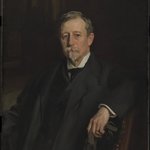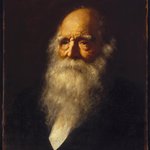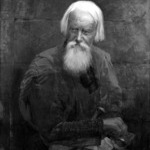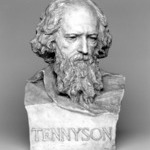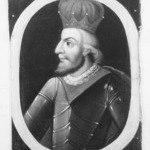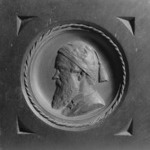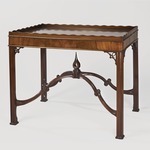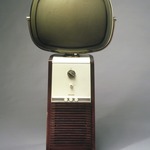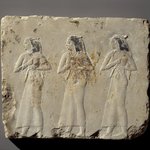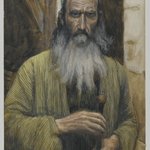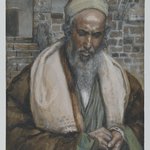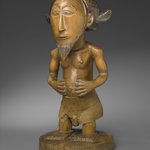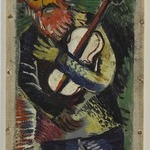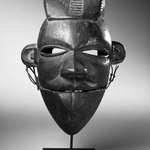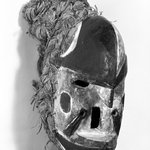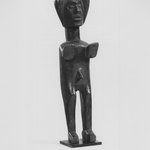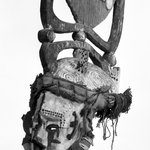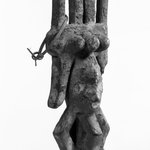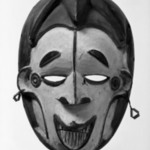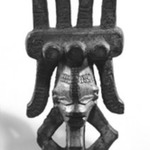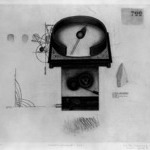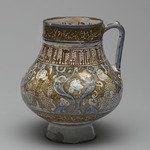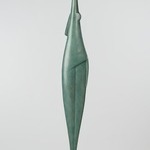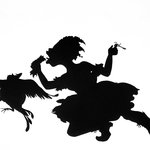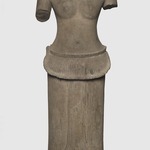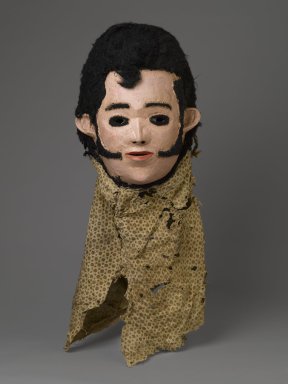
'Elvis' Mask for Nyau Society
Arts of Africa
ART OF SATIRE
Masks are particularly useful for expressing disapproval and thus reinforcing communal values. These two masks performed instructional and critical messages about proper behavior and political discontent.
Male Yoruba dancers wear gelede masks at festivals honoring the women of the community. Gelede often serves as a showcase for artistic innovation, with its masks depicting motifs that are both entertaining and critical. This mask depicts a French gendarme, a colonial soldier, and was most likely performed as a critique of French personal and political behavior during the colonial period.
The mask depicting Elvis Presley belonged to the Nyau society (to which all Chewa men belong), an institution that governs the spiritual realm of death and the ancestors. The society’s masks always represent the spirits of the deceased, but they may also represent wild bush spirits or caricature personalities from the wider community. Outsiders—including Swahili slave traders, British officials, the Virgin Mary, and other iconic foreigners such as Elvis Presley— have been considered representative of antisocial traits and undesirable values.
Masks are particularly useful for expressing disapproval and thus reinforcing communal values. These two masks performed instructional and critical messages about proper behavior and political discontent.
Male Yoruba dancers wear gelede masks at festivals honoring the women of the community. Gelede often serves as a showcase for artistic innovation, with its masks depicting motifs that are both entertaining and critical. This mask depicts a French gendarme, a colonial soldier, and was most likely performed as a critique of French personal and political behavior during the colonial period.
The mask depicting Elvis Presley belonged to the Nyau society (to which all Chewa men belong), an institution that governs the spiritual realm of death and the ancestors. The society’s masks always represent the spirits of the deceased, but they may also represent wild bush spirits or caricature personalities from the wider community. Outsiders—including Swahili slave traders, British officials, the Virgin Mary, and other iconic foreigners such as Elvis Presley— have been considered representative of antisocial traits and undesirable values.
CULTURE
Chewa
MEDIUM
Wood, paint, fiber, cloth
DATES
ca. 1977
DIMENSIONS
11 x 9 1/2 x 7 1/4 in. (27.9 x 24.1 x 18.4 cm) (show scale)



COLLECTIONS
Arts of Africa
ACCESSION NUMBER
2010.41
CREDIT LINE
Gift of Mr. and Mrs. J. Gordon Douglas III, Frederick E. Ossorio, and Elliot Picket, by exchange and Designated Purchase Fund
CATALOGUE DESCRIPTION
The object is a mask decorated to look like Elvis, carved from a single piece of wood with the eyes, mouth and nostrils pierced through; on the interior, tool marks are clearly visible. Synthetic hair has been attached around the open back of the head and defines the hair and sideburns as well as the eyes and eyebrows.
A fairly thick layer of pink paint has been applied over the front of the mask and over the edges of the hair. The bottom edge and interior of the mask are not painted. Darker pink is present on selected areas of the cheeks, forehead and chin. The lips are painted red.
Various textiles and burlap are attached around the edges with natural fiber twine through a series of holes in the wood and to each other with plastic-like thread. A strip of burlap is attached around the entire edge of the mask and a strip of knitted black material is applied over the burlap along the bottom edge. A beige textile with a light brown floral pattern is attached on top of the burlap and knitted fabric around the entire bottom edge and is stitched together in various places with the plastic thread. A strip of a red, blue and white checkered material is tied around the hair at the back of the head on the interior. Sections of the hair are also tied together with the plastic thread. Pieces of teal and purple yarn are also strung to the back of the head on the exterior.
Patches of white material (paper?) with circular openings have been applied to inside behind eyes to create the whites of the eyes, which are visible from the front.
EXHIBITIONS
MUSEUM LOCATION
This item is not on view
CAPTION
Chewa. 'Elvis' Mask for Nyau Society, ca. 1977. Wood, paint, fiber, cloth, 11 x 9 1/2 x 7 1/4 in. (27.9 x 24.1 x 18.4 cm). Brooklyn Museum, Gift of Mr. and Mrs. J. Gordon Douglas III, Frederick E. Ossorio, and Elliot Picket, by exchange and Designated Purchase Fund, 2010.41. Creative Commons-BY (Photo: Brooklyn Museum, 2010.41_PS6.jpg)
IMAGE
overall, 2010.41_PS6.jpg. Brooklyn Museum photograph, 2011
"CUR" at the beginning of an image file name means that the image was created by a curatorial staff member. These study images may be digital point-and-shoot photographs, when we don\'t yet have high-quality studio photography, or they may be scans of older negatives, slides, or photographic prints, providing historical documentation of the object.
RIGHTS STATEMENT
Creative Commons-BY
You may download and use Brooklyn Museum images of this three-dimensional work in accordance with a Creative Commons license. Fair use, as understood under the United States Copyright Act, may also apply.
Please include caption information from this page and credit the Brooklyn Museum. If you need a high resolution file, please fill out our online application form (charges apply).
For further information about copyright, we recommend resources at the United States Library of Congress, Cornell University, Copyright and Cultural Institutions: Guidelines for U.S. Libraries, Archives, and Museums, and Copyright Watch.
For more information about the Museum's rights project, including how rights types are assigned, please see our blog posts on copyright.
If you have any information regarding this work and rights to it, please contact copyright@brooklynmuseum.org.
RECORD COMPLETENESS
Not every record you will find here is complete. More information is available for some works than for others, and some entries have been updated more recently. Records are frequently reviewed and revised, and we welcome any additional information you might have.
